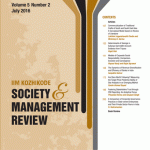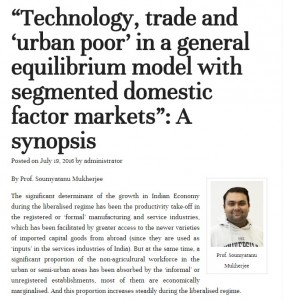Supply Chain Contracts in the Presence of Gray Markets
Abhishek Srivastava [1], Arqum Mateen [2]
The gray market (GM) refers to the practice of diverting a manufacturer’s branded genuine goods by an unauthorized dealer who operates outside the manufacturer’s authorized channel. Under such a scenario, manufacturers may suffer in terms of the erosion of brand reputation, reduced profitability and deterioration of channel relationships [5]. GM trades affect various industries including fashion, automobile, electronics, pharmaceutical, luxury watches, textbooks and computer hardware. There are many retail giants such as Amazon, eBay, Costco and Alibaba who have sold gray products through their e-platform [9], [10], [13]. GM sales of copyrighted works (such as books, music, and movies) have been estimated to be more than $220 billion a year [8]. Hence, the emergence of GM is becoming a major challenge for manufacturers, authorized distributors, brand conscious customers, and policymakers.
GMs may emerge when a manufacturing firm follows a price discrimination strategy to segment its market based on consumers purchasing power, geography and regulatory policies in various markets. This provides an opportunity for unauthorized dealers to purchase products from lower-priced markets and resell them to higher-priced markets below the authorized channel price in the latter market [1], [7]. It may also emerge when an authorized dealer/retailer diverts excess inventory to an unauthorized channel at a price lower than the prevailing authorized channel price to clear inventory at the end of the season [2], [3], [4], [6]. Other than large price differential and uncertain demand, one of the key drivers for the emergence of GMs is misaligned channel incentives like a large quantity discount, restrictive buying, and trade promotions offered by manufacturers, all of which may lead to authorized retailers inflating their order. As a result of over-ordering, many times authorized retailers resell part of their excess inventory to GMs [14]. Therefore, it is crucial for manufacturers to carefully choose a coordinating supply chain contract in a GM environment.
In our forthcoming paper in Decision Sciences [11], we analyse the performance of a number of contracts in the presence of a gray market – primarily wholesale price, revenue sharing and quantity discounts – and analyse their impact on prices charged, quantity ordered as well as profits. Our results indicate that selection of an appropriate contract is quite crucial, as different contracts give different results across a variety of operating parameters. Their performance is governed by the relative trade-offs involving diversion of excess quantity to the gray market at the end of the season, an extension of target market due to lower prices in the alternate channel, and the negative impact on the manufacturer’s brand which also affects its revenue. We delineate these characteristics and find that in general, the quantity discount contract performs the worst. Interestingly, if the blowback suffered by the manufacturer on account of product availability in the gray market is high, the wholesale price contract may outperform the other contracts, including the revenue sharing contract with a truthful retailer, which otherwise is a more attractive option.
We demonstrate a substantial difference in the performance of classical contracts in the presence of GM. The contracts which typically lead to increased profits through coordinating the supply chain (e.g., revenue sharing and quantity discount) in normal settings, may lead to the reduction in profit as well as the loss of brand reputation in the presence of GM. Therefore, for manufacturing firms operating in an environment where the possibility of the product diversion to the GM is high, then it is very crucial to choose contracts carefully. Specifically, when firms are offering channel incentives to motivate their distributors to purchase more.
Our analysis also provides quite a few pointers to practitioners. According to The New York Times (2018), luxury brand ’Burberry’ had burned $37 million of clothing and cosmetics at the end of a selling season so as to avoid dilution of its ’brand value’. Burberry used this practice to prevent unwanted items being diverted to the GM or sold at a significant discount which lead to eroding the high-end price tags which Burberry can command in stores. Our analysis suggests that such a drastic course of action may be avoided by proper design and enforcement of appropriate contractual mechanisms. For example, a revenue-sharing contract, with proper monitoring in place, can be quite useful in reducing unauthorised diversions. At the same time, for companies with multiple product lines (which may be positioned differently, and thus their brand erosion can be different), a portfolio approach may come in handy. For example, for a product with lower brand image loss, even the wholesale price contract can perform reasonably well. In effect, we are calling for a more nuanced design and application of different supply chain contracts to properly account for the presence of the GM.
Bibliography
[1] Ahmadi, R. and Yang, B.R. (2000). Parallel imports: Challenges from unauthorized distribution channels. Marketing Science, 19(3), pp.279-294.
[2] Ahmadi, R., Iravani, F. and Mamani, H. (2015). Coping with gray markets: The impact of market conditions and product characteristics. Production and Operations Management, 24(5), 762-777.
[3] Ahmadi, R., Iravani, F. and Mamani, H. (2017). Supply chain coordination in the presence of gray markets and strategic consumers. Production and Operations Management, 26(2), 252-272.
[4] Altug, M.S. (2017). The dynamics of domestic gray markets and its impact on supply chains. Production and Operations Management, 26(3), 525-541.
[5] Antia, K.D., Bergen, M.E., Dutta, S. and Fisher, R.J. (2006). How does enforcement deter gray market incidence?. Journal of Marketing, 70(1), 92-106.
[6] Dasu, S., Ahmadi, R. and Carr, S.M. (2012). Gray markets, a product of demand uncertainty and excess inventory. Production and Operations Management, 21(6), 1102-1113.
[7] Duhan, D.F. and Sheffet, M.J. (1988). Gray markets and the legal status of parallel importation. Journal of Marketing, 52(3), 75-83.
[8] KPMG, (2008). Effective channel management is critical in combating the gray-market and increasing technology companies bottom line. Retrieved from http://www.agmaglobal.org/cms/uploads/whitePapers/7-10-08KPMGWhitePaperGrayMarket-Study.pdf accessed 20 June 2018.
[9] Schonfeld, M. (2010). Fight Grey Goods with Trade Mark Law. No. 200 Managing Intellectual Property, 21.
[10] Stohr, Greg. (2013). eBay Wins as Top Court Backs Gray Market Discount Goods. Retrieved from https://www.bloomberg.com/news/articles/2013-03-19/-gray-market-backed-by-high-court-in-win-for-discounters Accessed Study.pdf accessed on 17 December 2018.
[11] Srivastava, A. and Mateen, A. Supply Chain Contracts in the Presence of Gray Markets. Decision Sciences. Forthcoming.
[12] Su, X. and Mukhopadhyay, S.K. (2012). Controlling power retailer’s gray activities through contract design. Production and Operations Management, 21(1), 145-160.
[13] SwissWatch Boutique LLC. 2007. Buying a watch on eBay. Retrieved from http://www.ebay.com/gds/Buying-a-Watch-on-eBay-/10000000000995034/g.html accessed on 17 December 2018.
[1] Doctoral Student, Indian Institute of Management Kozhikode
Email- abhisheks10fpm@iimk.ac.in
[2] Assistant Professor, Indian Institute of Management Kozhikode
Email – arqumm@iimk.ac.in
















 Users Today : 143
Users Today : 143 Users Yesterday : 488
Users Yesterday : 488 This Month : 9107
This Month : 9107 This Year : 9107
This Year : 9107 Total Users : 567351
Total Users : 567351 Who's Online : 8
Who's Online : 8